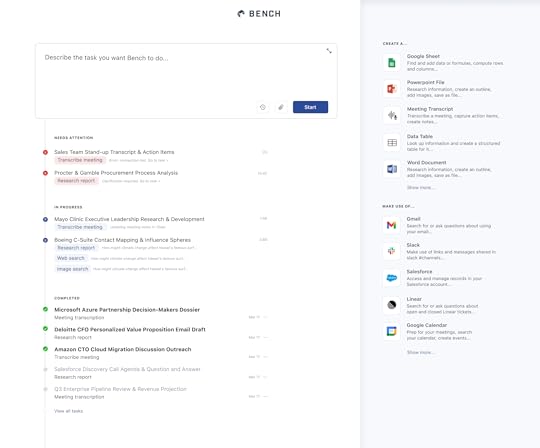Prompt Building User Interfaces
Perhaps the biggest problem facing AI products today is: people don't know all the things these products can do nor how to get the best results out of them. Not surprising when you consider most AI product interfaces are just empty text fields asking "what do you want to do?". Prompt building user interfaces can help answer that question and more.
We've been exploring ways to help people understand what's possible and how to accomplish it in Bench. Bench is AI for everyday work tasks. As such, it can do a lot: search the Web, browse the Web as you (with a browser extension), generate reports, make PowerPoint, use your email, and many more of the things that make up people's daily work tasks. The problem is... that's a lot.
To give people a better sense of what Bench can do, we started with suggested prompts (aka instructions) that accomplished specific work tasks. To make these as relevant as possible, we added an initial screen to the Bench start experience asking people to specify their primary roles at work: Engineering, Design, Sales, etc. If they did, the suggested prompts would be reflective of the kinds of things they might do at work. For example Sales folks would see suggestions like: research a prospect, prep for a sales meeting, summarize customer feedback, and so on.
The problem with these kinds of high level suggestions is they are exactly that: too high level. Though relevant to a role, they're not relevant to someone's current work tasks. Sales teams are researching prospects but doing it in a way that's specific to the product they're selling and the prospect they're researching. Generic prompt suggestions aren't that useful.
To account for this, we attempted to personalize the role-based suggestions by researching people's companies in the background while they signed up. This additional information allowed us to make suggestions more specific to the industry and company people worked for. This definitely made suggested prompts more specific, but it also made them less useful. Researching someone's company gives you some context but not nearly the amount its employees have. Because of this, personalized suggested prompts felt "off". So we went back to more generic suggestions but made them more atomic.
Instead of encompassing a complete work task, atomic suggestions just focused on part of it: where the information for a work task was coming from (look at my Gmail, search my Notion) and what the output of a work task should be (create a Word Doc, make a chart). These suggestions gave people a better sense of Bench's capabilities. It can read my calendar, it can make Google sheets. Almost immediately, though, it felt like these atomic suggestions should be combine-able.
To enable this, we made a prompt rewriter that would change based on what atomic suggestions people chose. If they picked Use Salesforce and Create Google Doc, the rewriter would merge these into a single instruction that made sense "Use [variable] from Salesforce to create a Google Doc". This turned the process of writing complex prompts into just clicking suggestions. The way these suggestions were laid out, however, didn't make clear they could be combined like this. They looked and felt like discrete prompts.
Enter the task builder. In the latest version of Bench, atomic suggestions have been expanded and laid out more like the building blocks of a prompt. People can either select what they want to do, use, make, or any combination of the three. The prompt rewriter then stitches together a machine-written prompt along with some optional inputs field people can fill in to provide more details about the work task they want to get done.
This prompt builder UI does a few things for people using Bench. It:
makes what the product can do clearer
provides a way to surface new functionality as it's added to the product
rewrites people's prompts in a way that gets them to better outcomes
clarifies what people can add to a prompt to make their tasks more effective
While that's a decent amount of good outcomes, design is never done and AI capabilities keep improving. As a result, I'm sure we're not done with not only Bench's task builder UI but solutions to discoverability and prompting in AI products overall. In other words... more to come.
Luke Wroblewski's Blog
- Luke Wroblewski's profile
- 86 followers





